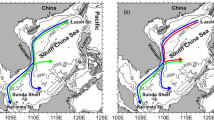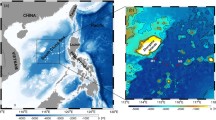Abstract
Using merged sea level anomaly and absolute geostrophic velocity products from satellite altimetry and Argos drifter data, we analyzed the reversal process of the South China Sea (SCS) western boundary current (SCSwbc) from a summer to winter pattern in 2011 and important oceanic phenomena during this process. Results show that the outbreak time of the northeast monsoon over the southern SCS lagged that over the northern SCS by about 1 month. During the SCS monsoon reversal period, the SCSwbc reversed rapidly into the winter pattern at the Guangdong continental slope in late September. Subsequently, the southward Vietnam coastal boundary current strengthened. However, the northward Natuna Current maintained a summer state until mid-October. Thus, the balance between the southward and northward currents was lost when they met, their junction moved gradually southward. However, a loop current formed southeast of Vietnam because the main stream of the Vietnam Offshore Current (VOC) remained near its original latitude. Meanwhile, the VOC and associated dipole circulation system strengthened. After mid-October, the northward Natuna Current began to weaken, the loop current finally shed, becoming a cool ring. The VOC and its associated dipole sub-basin circulation system also weakened gradually until it disappeared.
Similar content being viewed by others
References
Cai S Q, Long X M, Wang S A. 2007. A model study of the summer Southeast Vietnam Offshore Current in the southern South China Sea. Cont. Shelf Res., 27 (18): 2 357–2 372.
Chen G X, Hou Y J, Chu X Q. 2011. Mesoscale eddies in the South China Sea: mean properties, spatiotemporal variability, and impact on thermohaline structure. J. Geophys. Res., 116 (C6): C06018, http://dx.doi.org/10. 1029/2010JC006716.
Chu X Q, Xue H J, Qi Y Q, Chen G X, Mao Q W, Wang D X, Chai F. 2014. An exceptional anticyclonic eddy in the South China Sea in 2010. J. Geophys. Res. Oceans, 119 (2): 881–897. http://dx.doi.org/10.1002/2013JC009314.
Fang G H, Fang W D, Fang Y, Wang K. 1998. A survey of studies on the South China Sea upper ocean circulation. Acta Oceanographica Taiwanica, 37 (1): 1–16.
Fang G H, Susanto D, Soesilo I, Zheng Q A, Qiao F L, Wei Z X. 2005. A note on the South China Sea shallow interocean circulation. Advances in Atmospheric Sciences, 22 (6): 946–954.
Fang G H, Wang G, Fang Y, Fang W D. 2012. A review on the South China Sea western boundary current. Acta Oceanol. Sin., 31 (5): 1–10.
Fang W D, Fang G H, Shi P, Huang Q Z, Xie Q. 2002. Seasonal structures of upper layer circulation in the southern South China Sea from in situ observations. J. Geophys. Res., 107 (C11): 3 202, http://dx.doi.org/10.1029/2002JC001343.
Fang W D, Guo J J, Shi P, Mao Q W. 2006. Low frequency variability of South China Sea surface circulation from 11 years of satellite altimeter data. Geophys. Res. Lett., 33: L22612, http://dx.doi.org/10.1029/2006GL027431.
Fang W D, Guo Z X, Huang Y T. 1998. Observational study of the circulation in the southern South China Sea. Chin ese Sci ence Bull etin, 43 (11): 898–905.
Guo J S, Chen X Y, Sprintall J, Guo B H, Qiao F L, Yuan Y L. 2012. Surface inflow into the South China Sea through the Luzon Strait in winter. Chinese Journal of Oceanology and Limnology, 30 (1): 163–168.
Ho C R, Kuo N J, Zheng Q A, Soong Y S. 2000. Dynamically active areas in the South China Sea detected from TOPEX/ POSEIDON satellite altimeter data. Remote Sens. Environ., 71: 320–328.
Hu J Y, Kawamura H, Hong H S, Qi Y Q. 2000. A review on the currents in the South China Sea: seasonal circulation, South China Sea warm current and Kuroshio intrusion. J. Oceanogr., 56 (6): 607–624.
Hwang C, Chen S A. 2000. Circulations and eddies over the South China Sea derived from TOPEX/Poseidon altimetry. J. Geophys. Res., 105 (C10): 23 943–23 965.
Li L, Wu R S, Guo X G. 2000. Seasonal circulation in the South China Sea a TOPEX/POSEIDON satellite altimetry study. Acta Oceanologica Sinica, 22 (6): 13–26. (in Chinese with English abstract)
Li L. 2002. Advance in observational studies of upper layer circulations of the South China Sea. Journal of Oceanography in Taiwan Strait, 21 (1): 114–125. (in Chinese with English abstract)
Liu Q Y, Kaneko A, Su J L. 2008a. Recent progress in studies of the South China Sea circulation. J. Oceanogr., 64 (5): 753–762.
Liu Y G, Weisberg R H, Yuan Y C. 2008b. Patterns of upper layer circulation variability in the South China Sea from satellite altimetry using the self-organizing map. Acta Oceanologica Sinica, 27 (Suppl.): 129–144.
Liu Z Y, Yang H J, Liu Q Y. 2001. Regional dynamics of seasonal variability in the South China Sea. J. Phys. Oceanogr., 31 (1): 272–284.
Shaw P T, Chao S Y, Fu L L. 1999. Sea surface height variations in the South China Sea from satellite altimetry. Oceanol ogica Acta, 22 (1): 1–17.
Shaw P T, Chao S Y. 1994. Surface circulation in the South China Sea. Deep Sea Res. I: Oceanogr. Res. Paper., 41: 1 663–1 683.
Takano K, Harashima A, Namba T. 1998. A numerical simulation of the circulation in the South China Seapreliminary results. Acta Oceanographica Taiwanica, 37 (2): 165–186.
Wang D X, Hong B, Gan J P, Xu H Z. 2010. Numerical investigation on propulsion of the counter-wind current in the northern South China Sea in winter. Deep Sea Res. I: Oceanogr. Res. Paper., 57 (10): 1 206–1 221.
Wang D X, Liu Q Y, Xie Q, He Z G, Zhuang W, Shu Y Q, Xiao X J, Hong B, Wu X Y, Sui D D. 2013. Progress of regional oceanography study associated with western boundary current in the South China Sea. Chinese Science Bulletin, 58 (11): 1 205–1 215.
Wang G H, Chen D K, Su J L. 2006. Generation and life cycle of the dipole in the South China Sea summer circulation. J. Geophys. Res., 111 (C6): C06002, http://dx.doi.org/10. 1029/2005JC003314.
Wang G H, Su J L, Chu P C. 2003. Mesoscale eddies in the South China Sea observed with altimeter data. Geophys. Res. Lett., 30 (21), http://dx.doi.org/10.1029/2003GL018532.
Wu C R, Chang C-W J. 2005. Interannual variability of the South China Sea in a data assimilation model. Geophys. Res. Lett., 32 (17): L17611, http://dx.doi.org/10.1029/2005GL023798.
Wyrtki K. 1961. Physical oceanography of the Southeast Asian waters. In: NAGA Report Volume 2. Scientific Results of Marine Investigations of the South China Sea and the Gulf of Thailand, S.I.O. La Jolla, California. 195p.
Xiu P, Chai F, Shi L, Xue H J, Chao Y. 2010. A census of eddy activities in the South China Sea during 1993-2007. J. Geophys. Res., 115: C03012, http://dx.doi.org/10.1029/2009JC005657.
Yang H J, Liu Q Y, Liu Z Y, Wang D X, Liu X B. 2002. A General circulation model study of the dynamics of the upper ocean circulation of the South China Sea. J. Geophys. Res., 107 (C7): 3 085, http://dx.doi.org/10.1029/2001JC001084.
Yang H Y, Wu L X. 2012. Trends of upper-layer circulation in the South China Sea during 1959-2008. J. Geophys. Res., 117: C08037, http://dx.doi.org/10.1029/2012JC008068.
Author information
Authors and Affiliations
Corresponding author
Additional information
Supported by the UNESCO-IOC/WESTPAC Project “Response of marine hazards to climate change in the Western Pacific”, the Special Fund of Chinese Central Government for Basic Scientific Research Operations in Commonweal Research Institutes (No. GY0212172), and the Open Foundation of the Key Laboratory of Data Analysis and Applications, State Oceanic Administration (No. LDAA-2012-02)
Rights and permissions
About this article
Cite this article
Zhang, Z., Guo, J. & Guo, B. Reversal process of the South China Sea western boundary current in autumn 2011. Chin. J. Ocean. Limnol. 34, 608–618 (2016). https://doi.org/10.1007/s00343-016-4388-7
Received:
Revised:
Accepted:
Published:
Issue Date:
DOI: https://doi.org/10.1007/s00343-016-4388-7




